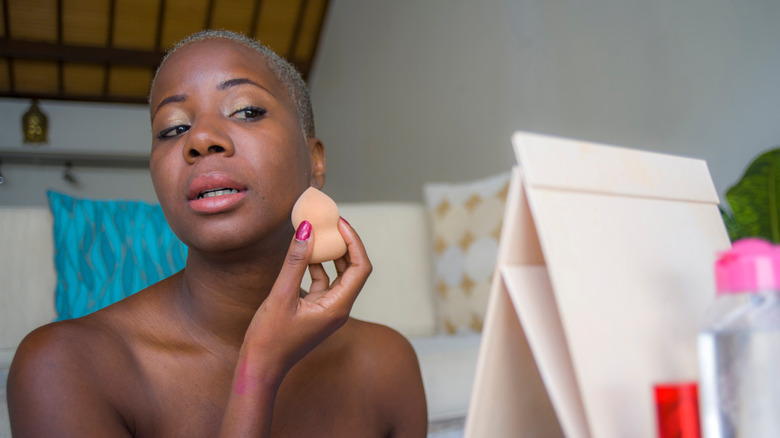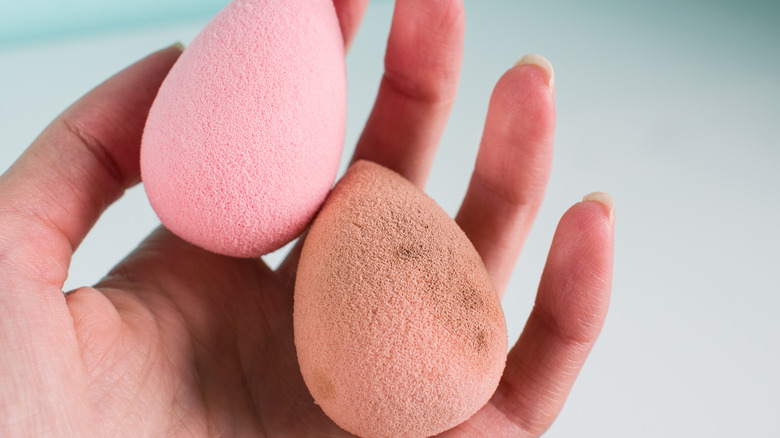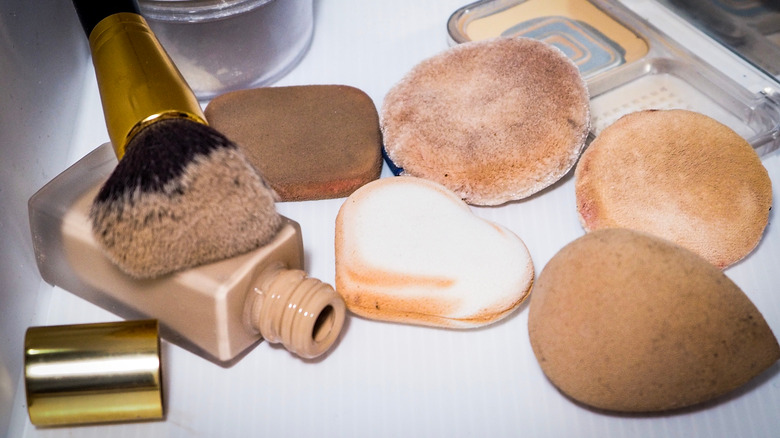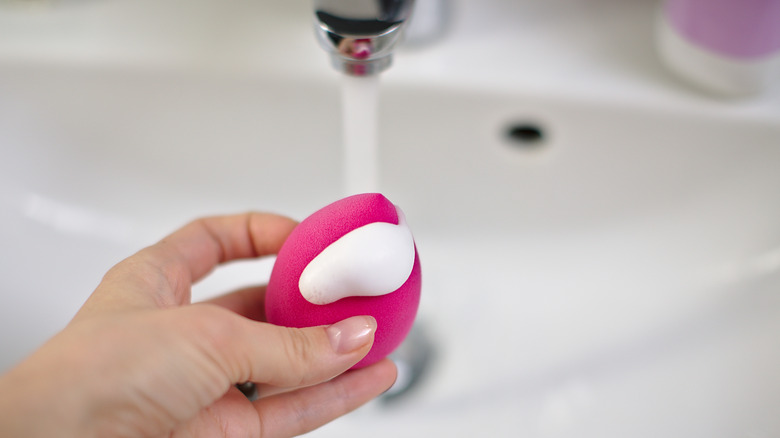Your Much Needed PSA To Clean Your Beauty Sponges Way More Often Than You Probably Are
There are so many perks to using beauty sponges when applying makeup. The innovative tool works beautifully with liquids, cream, and even powders, providing a skin-like finish. On top of that, beauty sponges work well throughout the day for touch-ups, as they don't deposit heavy amounts of product. They fill in pores with just the right level of foundation, leaving skin dewy and lustrous.
However, beauty sponges have a few points in the cons column. For one, they absorb a ton of product, and so a pricey foundation won't last as long when applied with a beauty sponge as opposed to fingers or brushes. The other drawback also involves the sponge's absorption rate. Not only do beauty sponges soak up foundation, they also absorb everything else, including natural oils on the face, as well as any germs that get picked up along the way.
And while many of us are already well aware that we're supposed to keep our beauty sponges clean, those of us who have grown accustomed to doing so once-a-week may be in for a rude awakening with the next bit of information. According to Bustle, beauty sponges needed to be cleaned after every single use to keep them sanitary. Yup. If that sounds like a lot, allow us to explain why this is necessary, along with everything you need to know about caring for your sponges.
Beauty sponges are highly susceptible to germs
All makeup and makeup applicators have the potential to harbor bacteria, but beauty sponges, according to the Journal of Applied Microbiology, have the highest risk of germs, including the bacteria "S. aureus, E. coli, and Citrobacter freundii." Yikes. As if that weren't frightening enough, the research conducted on pre-used products is even more alarming. The same journal published a 2020 study examining at the microbial content of various donated makeup tools and reported "the majority of contaminants [were] found to be staphylococci/micrococci. Enterobacteriaceae were also detected in all product types, with particularly high prevalence in the beauty blenders." There were also traces of fungi found in the sponges.
Why are beauty sponges so prone to bacteria and fungi? A major reason is that people frequently dampen their sponges prior to use, either with water or with a misting product. The moisture creates fertile ground for bacteria and fungus. On top of that, due to the density of the sponges themselves, the product buildup and bacteria can gather in the center, making it harder to clean than brushes fingers.
A dirty sponge could potentially get you sick
Uncleaned beauty sponges can lead to all sorts of skin concerns and risks. The bacteria, oil, product, and dead skin that accumulate in a sponge can, first and foremost, potentially clog up your pores and lead to acne as dermatologist Ava Shamban told Allure. Acne isn't the only worry, though. Shamban added, "That repeated contact could lead to an inflammatory rash."
Unfortunately, this isn't the end of the concerns from a dirty beauty sponge. A study from the Journal of Applied Microbiology illustrated that E. coli and other bacteria repeatedly coming into contact with your face — especially your eyes or mouth — can seriously increase a person's risk of developing infections. If a person has any open skin or cuts on the face, those odds are even higher, and for those who are immunocompromised, this risk is even more serious. So using clean sponges is absolutely essential.
The best ways to clean your beauty sponges
To avoid infection, acne, and contamination, it's imperative to clean beauty sponges thoroughly with soap after every single use. The good news is there are several methods to ensure a squeaky clean sponge without a ton of effort. Makeup artist Neil Scibelli told Real Simple that one trick is to use a textured beauty mat like a washboard. The silicone mat suctions to a surface, holding it in place, and the grooves in the silicone allow for better cleaning.
In addition to the beauty mat, Scibelli suggested using either a soap specifically made for the sponges, like Liquid Blender cleanser, or gentle cleansers like baby shampoo or castile soap. The sponge can also be presoaked in a soap solution if needed. After a few minutes, work it into a lather and rinse thoroughly.
There's also, somewhat surprisingly, a microwave trick. Fill a microwave-safe cup with soap and water, dampen the sponge, then put it in the cup and microwave for one minute. It'll be hot when it comes out, but once it cools, squeeze out the excess, rinse, and allow the sponge to dry. There's a great oil hack too. Esthetician Renée Rouleau told Women's Health to mix two-to-one parts dish soap with olive oil and use this mixture on a dry beauty sponge. Allow the mixture to fully absorb before rinsing with warm water. Even with all of this cleaning, a beauty sponge needs to be replaced every three months.



